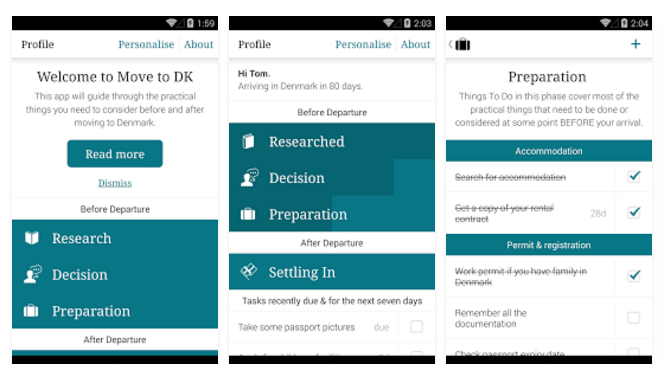Source: https://flic.kr/p/bxR4gf
Hans Christian Andersen, the Little Mermaid, Tivoli Gardens, and Danny Kaye – they all conjure up the visions of Denmark inviting you to make it your new home.
Copenhagen, the capital, is home to royal palaces and colorful Nyhavn harbor, plus the Tivoli amusement park and the iconic “Little Mermaid” statue. Odense, 104 miles (165 km) away, is the hometown of writer Hans Christian Andersen. With its medieval core of cobbled streets and half-timbered houses, it is one of Denmark’s oldest cities.
Depending on your preference there are many choices for both country and city living.
Here are some tips to help make moving to Denmark that much easier:
1. Use technology to get started
Start off by downloading the “Moving to Denmark App” from the Google Play or the App Store:
This App simplifies the process of relocating to Denmark. It provides a checklist of points to take care of before and after moving. It also includes a To Do list with the ability to create your own personal checklist.
2. Residence and work permits
Before arriving in Denmark and starting to work, you will need a residence and work permit. New citizens must notify the Citizens Service Center of the local municipality within five days of arrival, being issued a residence permit, or receiving a registration card and a Civil Registry number – also known as the CPR number.
A CPR number is required to receive various services in Denmark, including:
- Opening a bank account
- Connecting utilities
- Getting insurance
- Joining a library
- Access to publicly funded healthcare
- Salary
- Buying a house
More information is available from the official government website for foreigners, here.
Work Permits: Most foreign nationals need a work permit before they can begin working. If your stay is shorter than three months, you can perform certain types of activity, which includes teaching, attending a course or participating in meetings, negotiations, briefings and training, without these permits.
3. Learn Danish
Although English is widely spoken and understood, if you want to get ahead, integrate into society, and get a good job, you should learn Danish. There are plenty of opportunities to learn Danish and many types of courses are available for free if you have a CPR number or a work contract.
4. Learn about the local traditions and food
Danes are generally extremely liberal but also very traditional. Every season, feast, holiday, and celebration has a Danish tradition. Christmas, Easter and St. John’s Eve (at the end of June) are among the most important. Other include “Fastelavn” in February, New Years, and Great Prayer Day.
Most Danish traditions revolve around food:
- Chocolate Easter Eggs
- Goose or duck dishes eaten in honor of Morten’s Night on the 10th of November
- varme hveder – a traditional bread- on Great Prayer Day (Store Bededag) – the 4th Friday after Easter (seen below)
Source: https://flic.kr/p/JFy3t
Other important Danish traditions include saying “thank you” for almost everything. It is integrated into the language and most conversations. And don’t forget one of the most important traditions – leaving your shoes on the doorstep when you enter a house.
5. Prepare and pack for Danish weather
According to the Danes, there is no bad weather – just the wrong clothing. Wear layers and invest in some waterproof or Wellington boots. Denmark has warm summer days, colorful autumns, green springs and cold, snowy winters. The weather is always a factor, and DMI (the Denmark’s national weather service), gives you the most accurate forecast.
Make sure you know what clothing and accessories to bring on an international move.
6. Find a job
If not relocating with your current job, you will need to find gainful employment pretty quickly. The Danish job market is dynamic. Search the job ads on databases like Jobindex.dk and WorkinDenmark.dk. Unless you’re a perfect fit, you’ll be competing with many locals who speak the language and have local smarts on their side. English will be an asset, but getting ahead will really require Danish (See point #3).
Study the ads to figure out what skills companies are looking for. Upgrade your CV to highlight those skills. Go to as many professional events as possible, chat with people, ask about your industry, and then leverage that knowledge in your job applications.
7. Find Accommodation
Try to find a house before you move. This can be a challenge and it usually takes time, especially in the large Danish cities. Search online through Denmark’s many housing portals and in the Danish newspaper ads. Alternatively, you can contact a real estate agent, rental agency or relocation partner. The most common approach among newcomers is to rent a house or apartment. Buying a property can be a valid alternative if you plan to stay in Denmark for a longer period. It is highly recommended that you consult a lawyer specializing in property law to help through whichever approach you decide to adopt.
8. Enroll your child in school
Education is compulsory between the ages of 7 and 16. Families have the choice of sending their children to public, private or international schools, but parents must have a CPR number before they can enroll children in any form of education or child care.
Municipal primary and lower secondary schools (folkeskole) provide free education to approximately 87% of all Danish children. Schools are co-ed and there is no school uniform. Private education is usually financed by a combination of state subsidy and fees paid by the child’s family.
9. Hire the right moving company
Last, but certainly not least, when moving to Denmark, it is important to hire a moving company with experience in international moving to make sure your possessions arrive at your new home safe and sound, without any bureaucratic issues.
Whether you are moving for work or simply because you want to live in the land of fairy tales, these tips will help make the transition a smooth one, so you can settle in and quickly start enjoying your life in Denmark.





